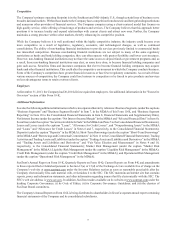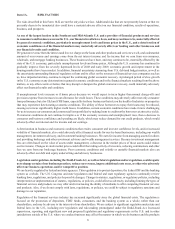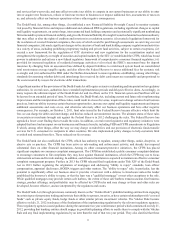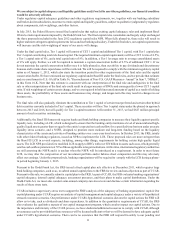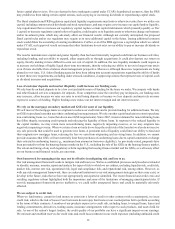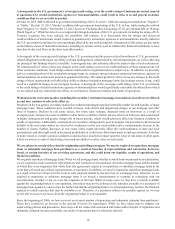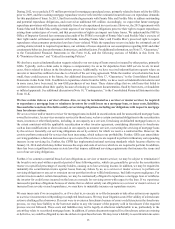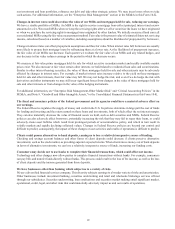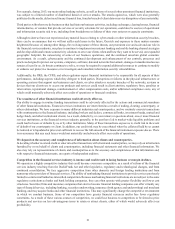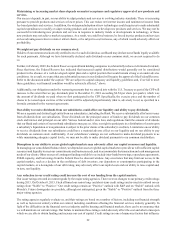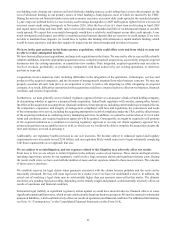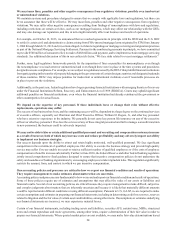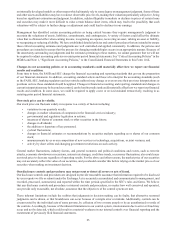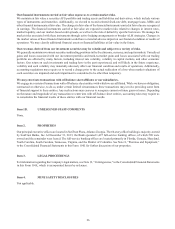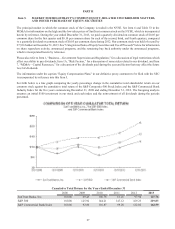SunTrust 2013 Annual Report Download - page 33
Download and view the complete annual report
Please find page 33 of the 2013 SunTrust annual report below. You can navigate through the pages in the report by either clicking on the pages listed below, or by using the keyword search tool below to find specific information within the annual report.17
principle, we have committed to provide $500 million of consumer relief, to make a $468 million cash payment, and to
implement certain mortgage servicing standards.
We are continuing to negotiate definitive settlement terms for each of these matters and have certain substantive disagreements
with some of the positions being taken by the Government. We may be unable to resolve our disagreements with the Government
and may not reach a definitive settlement agreement as it relates to the FHA matter. If we do not reach a definitive settlement
agreement, then the Government may sue us alleging deficiencies in our FHA loan origination practices. We are not able to
predict the effect that a failure to resolve the FHA matter will have on the agreement in principle to settle the alleged claims
regarding our mortgage servicing and origination practices.
Our financial statements at December 31, 2013 reflected our estimated cost of the settlements, and we are not able to predict
what our ultimate cost to resolve these matters will be if we are not able to reach definitive settlement agreements. Even if
we were to reach a definitive settlement agreement with the Government to resolve the alleged mortgage servicing and
origination claims as contemplated by the agreement in principle, we face the risk of being unable to meet certain consumer
relief commitments, resulting in increased costs to resolve this matter. Additionally, while we do not expect the consumer
relief efforts or implementation of certain servicing standards associated with the settlements to have a material impact on
our future financial results, this expectation is based on anticipated requirements of the definitive agreements which the parties
have not finalized.
We may continue to suffer increased losses in our loan portfolio despite enhancement of our underwriting policies and
practices.
We seek to mitigate risks inherent in our loan portfolio by adhering to specific underwriting policies and practices, which
often include analysis of a borrower's credit history, financial statements, tax returns and cash flow projections; valuation of
collateral based on reports of independent appraisers; and verification of liquid assets. Our underwriting policies, practices
and standards are periodically reviewed and, if appropriate, enhanced in response to changing market conditions and/or
corporate strategies. Examples include: client eligibility requirements, documentation requirements, loan types, collateral
types, LTV ratios, and minimum credit scores. Prior reviews have resulted in more stringent documentation standards, lower
maximum LTV ratios, and channel and client type restrictions. These actions have contributed to a reduction in exposure to
certain higher risk portfolio segments, such as higher risk mortgage, home equity, and commercial construction. These actions
have also contributed to declines in early stage delinquencies and NPLs. While these changes have resulted in improving asset
quality metrics, elevated losses may continue to occur due to economic factors, changes in borrower behavior, or other factors.
Our mortgage production and servicing revenue can be volatile.
We earn revenue from fees we receive for originating mortgage loans and for servicing mortgage loans. When rates rise, the
demand for mortgage loans usually tends to fall, reducing the revenue we receive from loan originations. Under the same
conditions, revenue from our MSRs can increase through reductions in the decay, or amortization, of the MSR asset. When
rates fall, mortgage originations usually tend to increase and mortgage servicing income tends to decline given increases in
the decay, or amortization, of the MSR asset. Even though the MSR asset can act as a “natural hedge,” the hedge is not perfect,
nor is it designed to be, either in amount or timing. Servicing income can also be impacted by the change in the fair value of
the MSR asset due to changes in market interest rates and other assumptions, exclusive of decay of the MSR asset. We use
derivatives to hedge the risk of changes in the fair value of the MSR, exclusive of decay. The hedge may not be effective and
may cause volatility, or losses, in our mortgage servicing income.
During 2012, our mortgage production income benefited from high levels of refinancing activity and historically high gain
on sale margins for our mortgage loans. In contrast, during the second half of 2013, increased interest rates caused mortgage
applications and refinancing activity to decline substantially, and this adversely affected mortgage production income. Our
mortgage production income likely will continue to be depressed as long as gain on sale margins remain narrow and until
refinance and purchase activity improves.
We typically use derivatives and other instruments to hedge our mortgage banking interest rate risk. We generally do not hedge
all of our risk, and we may not be successful in hedging any of the risk. Hedging is a complex process, requiring sophisticated
models and constant monitoring. We may use hedging instruments tied to U.S. Treasury rates, LIBOR or Eurodollars that may
not perfectly correlate with the value or income being hedged. We could incur significant losses from our hedging activities.
There may be periods where we elect not to use derivatives and other instruments to hedge mortgage banking interest rate
risk. For additional information, see Note 16, “Derivative Financial Instruments,” to the Consolidated Financial Statements
in this Form 10-K.


